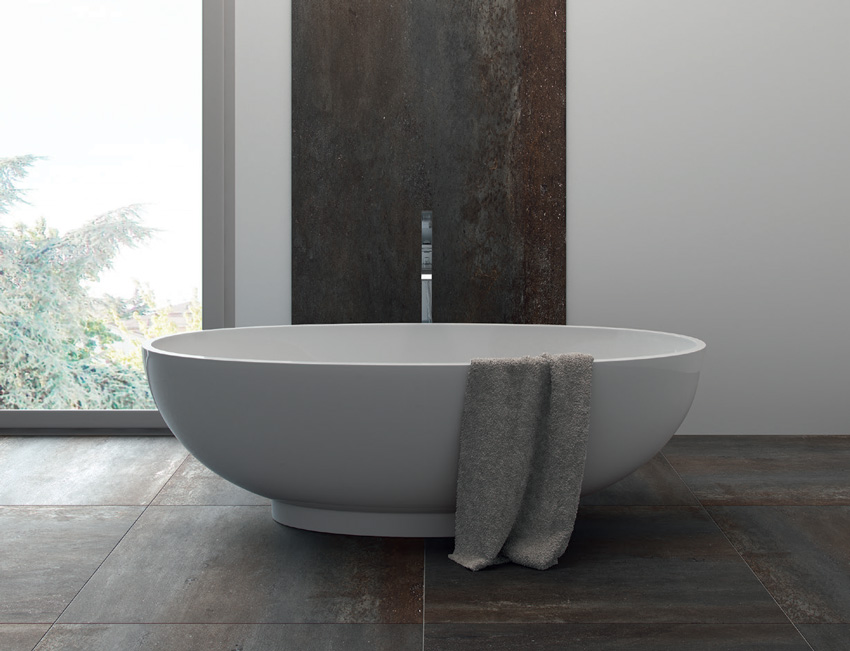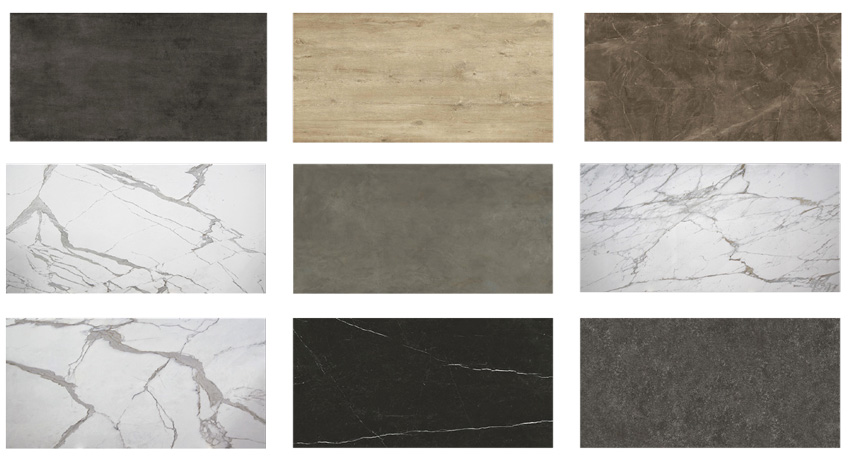Large-Size Porcelain Slabs for Building Surfaces
Technical Specifications
When specifying porcelain slabs, there are, as we have seen, numerous choices and options to select from. Coordination with manufacturers during the design phases of a project will help gain insight into project-specific details, cost drivers, installation nuances, and the latest finish options. In a standard CSI or master spec format, the usual location to include this spec is in Section 09 30 13 Ceramic/Porcelain Tiling. Some of the relevant items to address in a standard three-part specification format are highlighted as follows.

Color, pattern, and edge conditions of large porcelain tile can all be specified with a range of results possible, as shown on the wall and floor of this bathtub area.
Part One: General
The scope of specification work can include all preparation work, substrate review, product choices, and final installation. In carrying out the work, the following standards can be referenced:
- ANSI A137.1: American National Standards Specifications for Ceramic Tile
- ANSI A137.3: American National Standard Specifications for Gauged Porcelain Tiles and Gauged Porcelain Tile Panels/Slabs
- ANSI A108.19: Interior Installation of Gauged Porcelain Tiles and Gauged Porcelain Tile Panels/Slabs by the Thin-Bed Method Bonded with Modified Dry-Set Cement Mortar or Improved Modified Dry-Set Cement Mortar
- ASTM F1869: Standard Test Method for Measuring Moisture Vapor Emission Rate of Concrete Subfloor Using Anhydrous Calcium Chloride.
- ASTM F2170: Standard Test Method for Determining Relative Humidity in Concrete Floor Slabs Using in-situ Probes
Submittals for porcelain products should include the usual manufacturer’s data and information for all products used, plus recommended maintenance and cleaning information to be passed on to the building owner/operators.
Quality assurance is clearly an important part of any field-installed system, and the same is true here. It begins with the use of trained installers and applicators with a prescribed minimum number of years of experience. Evidence of such qualifications can be requested as a submittal, but it is important that the people actually in the field are the ones with the qualifications and experience needed. Protecting products and materials at the site is always important. Fortunately, since the interior work is often done at the very end of a project, the environmental conditions should be controllable.
Part Two: Products
All of the relevant porcelain products used in the building should be called out and specified, whether for interior or exterior applications. Each porcelain product should be identified by type in the specifications and shown on a schedule as appropriate in either the drawings or specifications. The details of the specified products can include:
- specific color and texture or pattern. Manufacturer’s literature should be consulted for this as with any finish product.
- recommended level (i.e., light duty, heavy duty, commercial duty, etc.).
- dynamic coefficient of friction (DCOF) for floor or stair materials.
- glaze hardness measured in standard units.
- shade variation tolerance on color.
- breaking strength as measured using standard tests.
In addition, the particular finishing details of the product should be specified for each type of porcelain product used. Hence, if back mesh (BM) fiberglass reinforcing is needed, it should be specified. Similarly, if rectified edges are desired, that should also be specified for the particular product.
In general, most porcelain ceramic tile does not require sealing so sealants do not need to be included or called for unless there are conditions or situations where the manufacturer recommends it or requires it.


Bottom: Photo courtesy of FLORIM
Large, thin porcelain slabs can be specified in a range of colors, textures, and finishes based on offerings from manufacturers.
Part 3: Execution
As with any finish product, the installation requires multiple steps that need to be clearly articulated in the specification in order to receive the best results.
- Examination and preparation: The importance of this work should be stressed. In addition to the architect, the installer should review and examine the substrate for conditions affecting the performance of the porcelain. Any issues will need to be corrected if they are found to be out of compliance with the requirements of the specifications. All surface defects must be repaired, and all joints and cracks shall be repaired using appropriate materials. Ultimately, the goal is to provide a substrate surface that has been prepared to an acceptable level, is clean of all contaminants, and free of any debris.
- Attachment: For some exterior applications, the method of attachment may require a separate aluminum system to hold and secure the porcelain in place. Such a system should be specified and installed accordingly. For other applications, the method of attachment may be based on standard ceramic tile installation methods using epoxy adhesive or regular- or thin-set compound and grout.
- Placement: The porcelain panels should be placed in the prepared areas according to the patterns and layouts shown on the drawings and in accordance with manufacturers' instructions or recommendations.
- Protection: Once applied, the finish surface needs to be protected during any remaining construction work, including final mechanical or electrical trimming, painting, or any punch list work. If the porcelain is the finish flooring, it needs to be covered and protected just like any other flooring.
Upon completion, all of the porcelain surfaces should be cleaned following manufacturers’ recommendations to produce a complete installation. Cleaning instructions should be provided to the building owner/operators as well. Porcelain ceramic is a relatively maintenance-free product that requires little continuing care beyond regular cleaning. Most cleaning can be done with a damp cloth and a gentle non-acidic soap. More resistant staining, such as calcium spotting and soap scum, can be handled using pH-neutral cleaning products designed for such purposes. Some manufacturers also offer products specially formulated for ceramic tile care. Take care to avoid over-the-counter ceramic tile cleaners that contain phosphoric and glycolic acids that could etch some ceramic tile surfaces.
When specified and installed correctly, large porcelain slabs can work quite well with other construction and help achieve excellent finished results.
Conclusion
Large porcelain slabs provide all of the beneficial characteristics of porcelain tile with dramatic design possibilities. They can have the appearance to rival natural stone, but in a product that is only half-inch-thick and lighter in weight than stone. Or they can provide a rich color, wood grain, or other pattern to a surface. The technical capabilities of porcelain slabs allow them to be used in a wide variety of interior and exterior applications and perform well over time in both new construction and renovation projects. Engaging with the manufacturers to review product information and details helps assure that the best products are selected and specified for a particular building. Properly done, the result will be a long lasting, durable, and well-designed solution for all involved.
References
American National Standards Institute (ANSI) A137.1: American National Standards Specifications for Ceramic Tile and A108.01–A108.19: Installation Standards (www.ansi.org)
International Organization for Standardization (ISO) Working Group 4 Thin Ceramic Tiles and Panels – Definitions, classification, characteristics and marking, installation (www.iso.org)
Tile Council of North America (TCNA) 2014 Handbook of Ceramic, Glass, and Stone Tile Installation (www.tcnatile.com)
United States Green Building Council (USGBC) LEED rating system (www.usgbc.org)
Peter J. Arsenault, FAIA, NCARB, LEED AP, is a practicing architect, green building consultant, continuing education presenter, and prolific author engaged nationwide in advancing building performance through better design. www.linkedin.com/in/pjaarch.

|
Since 1952, Walker Zanger has combined traditional tile-making techniques with a modern sophistication that transcends any singular design style. A leading choice for design professionals and consumers, its natural stone and tile products are found in luxury homes, trendy boutiques, and fine restaurants around the globe. www.walkerzanger.com |








